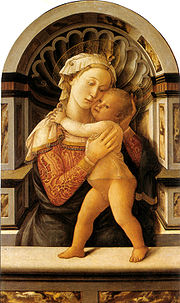
Regina Coeli
Encyclopedia

Queen of Heaven
Queen of Heaven is a title given to the Blessed Virgin Mary by Christians, mainly of the Roman Catholic Church, and also, to some extent, in the Anglican, Lutheran, and Eastern Orthodox churches, to whom the title is a consequence of the Council of Ephesus in the fifth century, where the Virgin...
", pronounced reˈdʒiːna ˈtʃɛːli in ecclesastical Latin), an ancient Latin Marian Hymn
Hymns to Mary
Marian Hymns are Christian songs focused on the Virgin Mary. They are used in both devotional and liturgical services, particularly by the Roman Catholic, Eastern Orthodox, Anglican, and Lutheran churches. They are often used in the month of May devotions. Some have also been adopted as Christmas...
of the Christian Church, is one of the four seasonal Marian antiphons of the Blessed Virgin Mary, prescribed to be sung or recited in the Liturgy of the Hours
Liturgy of the hours
The Liturgy of the Hours or Divine Office is the official set of daily prayers prescribed by the Catholic Church to be recited at the canonical hours by the clergy, religious orders, and laity. The Liturgy of the Hours consists primarily of psalms supplemented by hymns and readings...
at the conclusion of the last of the hours to be prayed in common that day, typically night prayer (Compline
Compline
Compline is the final church service of the day in the Christian tradition of canonical hours. The English word Compline is derived from the Latin completorium, as Compline is the completion of the working day. The word was first used in this sense about the beginning of the 6th century by St...
or Vespers
Vespers
Vespers is the evening prayer service in the Western Catholic, Eastern Catholic, and Eastern Orthodox, Anglican, and Lutheran liturgies of the canonical hours...
). The Regina Caeli is sung or recited in place of the Angelus
Angelus
The Angelus is a Christian devotion in memory of the Incarnation. The name Angelus is derived from the opening words: Angelus Domini nuntiavit Mariæ The Angelus (Latin for "angel") is a Christian devotion in memory of the Incarnation. The name Angelus is derived from the opening words: Angelus...
during the Easter season, from Holy Saturday
Holy Saturday
Holy Saturday , sometimes known as Easter Eve or Black Saturday, is the day after Good Friday. It is the day before Easter and the last day of Holy Week in which Christians prepare for Easter...
through Pentecost
Pentecost
Pentecost is a prominent feast in the calendar of Ancient Israel celebrating the giving of the Law on Sinai, and also later in the Christian liturgical year commemorating the descent of the Holy Spirit upon the disciples of Christ after the Resurrection of Jesus...
Sunday. The Latin word coelum, meaning "heaven" (whence the English word celestial) was a common medieval and early modern spelling of caelum, which was the only form in Classical Latin. In mediaeval Latin, ae and oe were both pronounced [eː]; the form was also influenced by an extremely dubious etymology from Greek koilos, "hollow".
While the authorship of the Regina Caeli is unknown, the hymn has been traced back to the twelfth century. It was in Franciscan
Franciscan
Most Franciscans are members of Roman Catholic religious orders founded by Saint Francis of Assisi. Besides Roman Catholic communities, there are also Old Catholic, Anglican, Lutheran, ecumenical and Non-denominational Franciscan communities....
use, after Compline, in the first half of the following century. Legend has it that St Gregory the Great
Pope Gregory I
Pope Gregory I , better known in English as Gregory the Great, was pope from 3 September 590 until his death...
heard angels chanting the first three lines one Easter
Easter
Easter is the central feast in the Christian liturgical year. According to the Canonical gospels, Jesus rose from the dead on the third day after his crucifixion. His resurrection is celebrated on Easter Day or Easter Sunday...
morning in Rome, while following barefoot in a great religious procession the icon of the Virgin painted by Luke the Evangelist
Luke the Evangelist
Luke the Evangelist was an Early Christian writer whom Church Fathers such as Jerome and Eusebius said was the author of the Gospel of Luke and the Acts of the Apostles...
. He was thereupon inspired to add the fourth line.
There are plainsong
Plainsong
Plainsong is a body of chants used in the liturgies of the Catholic Church. Though the Eastern Orthodox churches and the Catholic Church did not split until long after the origin of plainchant, Byzantine chants are generally not classified as plainsong.Plainsong is monophonic, consisting of a...
melodies (a simple and an ornate form) associated with Regina Caeli, the official or "typical" melody being found in the Vatican Antiphonary, 1911, p. 126. The antiphon
Antiphon
An antiphon in Christian music and ritual, is a "responsory" by a choir or congregation, usually in Gregorian chant, to a psalm or other text in a religious service or musical work....
al strophes of Regina Caeli were often set by polyphonic composers of the 16th century. Lully
Lully
-Places:*Switzerland**Lully, Fribourg, a municipality**Lully, Vaud, a municipality**Lully, Geneva, a village in the municipality of Bernex*France**Lully, Haute-Savoie-People:*Jean-Baptiste Lully , an Italian-born Baroque composer of French opera...
's motet “Regina coeli, laetare” was written in 1684. There are three settings by the young Mozart
Wolfgang Amadeus Mozart
Wolfgang Amadeus Mozart , baptismal name Johannes Chrysostomus Wolfgangus Theophilus Mozart , was a prolific and influential composer of the Classical era. He composed over 600 works, many acknowledged as pinnacles of symphonic, concertante, chamber, piano, operatic, and choral music...
, K.108, K.127, and K.276.
The Marian anthems run the gamut of medieval literary styles, from the classical hexameter
Hexameter
Hexameter is a metrical line of verse consisting of six feet. It was the standard epic metre in classical Greek and Latin literature, such as in the Iliad and Aeneid. Its use in other genres of composition include Horace's satires, and Ovid's Metamorphoses. According to Greek mythology, hexameter...
s of the Alma Redemptoris Mater through the richly-rhymed accentual rhythm and regular strophes of the Ave Regina Caelorum, the irregular syntonic strophe of the Regina Caeli, to the sonorous prose rhythms with rhyming closes of the Salve Regina. "In the 16th century, the antiphons of our Lady were employed to replace the little office at all the hours" (Baudot, The Roman Breviary, 1909, p. 71).
Latin text
- Regina caeli, laetare, alleluia:
- Quia quem meruisti portare, alleluia,
- Resurrexit, sicut dixit, alleluia,
- Ora pro nobis Deum, alleluia.
In the Office of Paul VI the Regina caeli ends here, but the older usage continues with the following versicle and prayer:
- V. Gaude et laetare, Virgo Maria, alleluia.
- R. Quia surrexit Dominus vere, alleluia.
Oremus. Deus, qui per resurrectionem Filii tui, Domini nostri Iesu Christi, mundum laetificare dignatus es: praesta, quaesumus, ut per eius Genitricem Virginem Mariam, perpetuae capiamus gaudia vitae. Per eundem Christum Dominum nostrum. Amen.
English text
Literal translation:- Queen of Heaven, rejoice, alleluia.
- For He whom you did merit to bear, alleluia.
- Has risen, as He said, alleluia.
- Pray for us to God, alleluia.
- V. Rejoice and be glad, O Virgin Mary, alleluia.
- R. For the Lord has truly risen, alleluia.
Let us pray. O God, who gave joy to the world through the resurrection of Thy Son, our Lord Jesus Christ, grant we beseech Thee, that through the intercession of the Virgin Mary, His Mother, we may obtain the joys of everlasting life. Through the same Christ our Lord. Amen.
An alternate translation:
- Joy to thee, O Queen of Heaven. Alleluia!
- He whom Thou wast meet to bear. Alleluia!
- As He promised hath arisen. Alleluia!
- Pour for us to God thy prayer. Alleluia!
- V. Rejoice and be glad, O Virgin Mary, alleluia.
- R. For the Lord is risen indeed, alleluia.
Let us pray,
O God, who through the resurrection of Thy Son our Lord Jesus Christ didst vouchsafe to give joy to the world: grant, we beseech thee, that through His Mother, the Virgin Mary, we may obtain the joys of everlasting life. Through the same Jesus Christ our Lord. Amen.
In Anglican
Anglicanism
Anglicanism is a tradition within Christianity comprising churches with historical connections to the Church of England or similar beliefs, worship and church structures. The word Anglican originates in ecclesia anglicana, a medieval Latin phrase dating to at least 1246 that means the English...
churches, the alternate translation above which is in 7.7.7.7 metre is usually sung to hymn tune known as Easter Hymn, "Jesus Christ is Risen Today" or the hymn tune "Ave Virgo Virginum".

